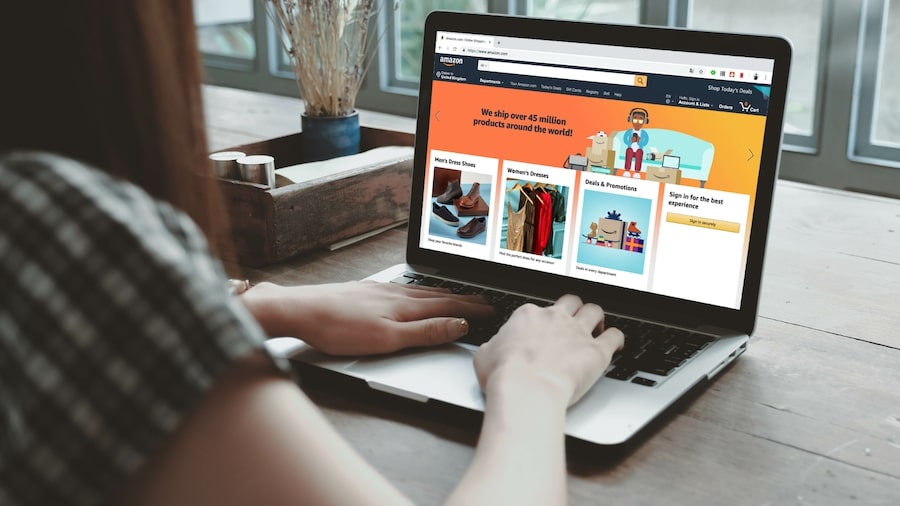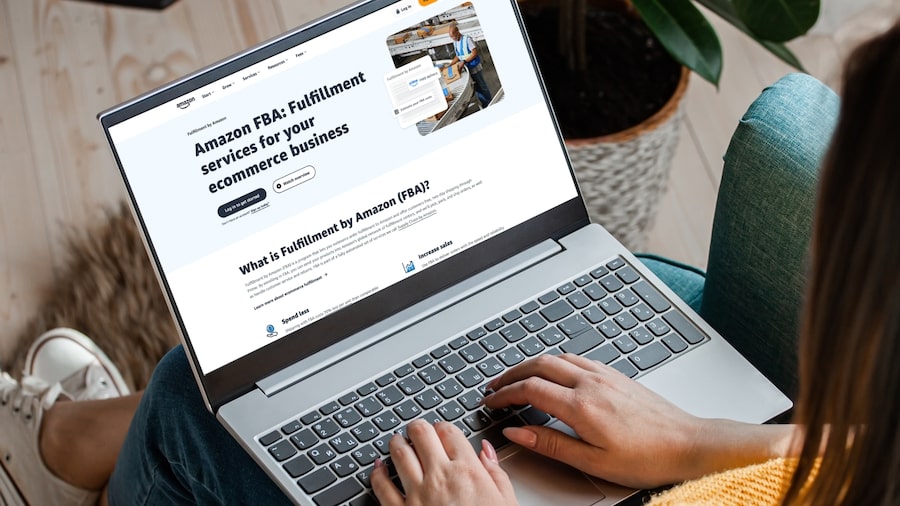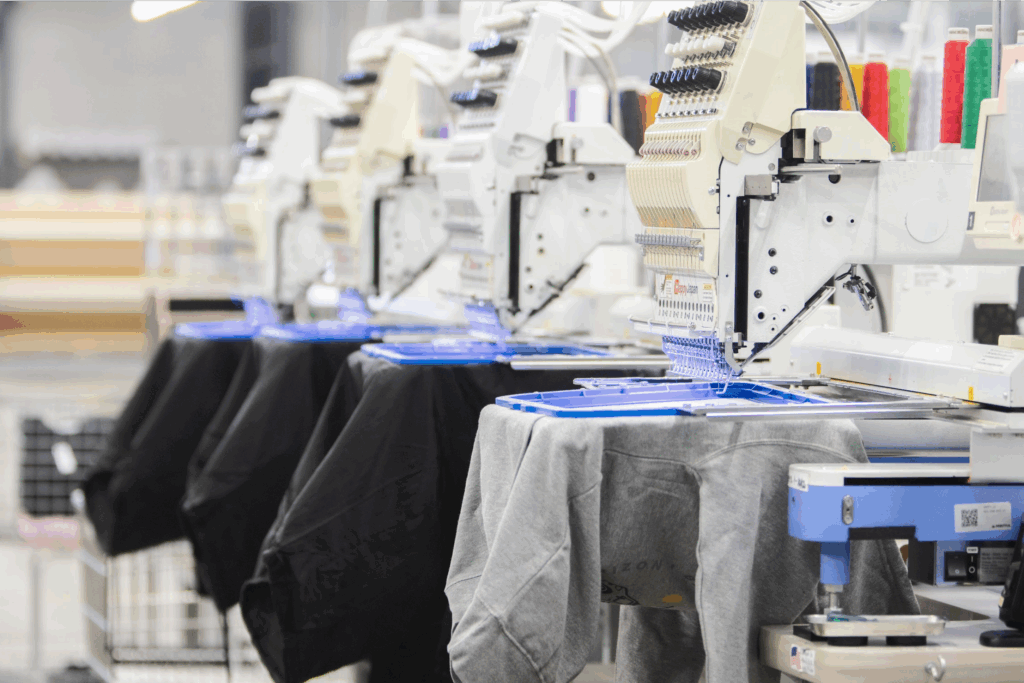Sell custom products with Printify
Selling on Amazon can be profitable, but only if you understand its various fees to manage your profits effectively. Amazon fees directly impact your margins, so knowing where every dollar goes is essential.
We’ll unpack the intricacies of Amazon seller fees in 2026, from referral fees and fulfillment costs to refund charges, storage rates, and more. Whether you’re a seasoned seller or just starting, this guide will help you price with confidence and protect your profits.
Key takeaways
- Amazon seller fees affect every item sold – including referral fees, fulfillment fees, and refund administration charges. Tracking these costs is essential to protecting your profit margins.
- The referral fee is calculated as a portion of the total sales price, which includes item price and shipping costs. This affects how you price your products.
- FBA sellers also pay monthly inventory storage fees and FBA fulfillment fees, which can increase during peak seasons or if products stay in the warehouse too long.
- Items like books, DVDs, and video game consoles may include a variable closing fee, so check the fee schedule before listing.
- If your item is refunded, Amazon keeps part of the original referral fee as a refund administration fee, which can reduce your overall sales proceeds.
Use the Amazon revenue/fee calculator to estimate your specific costs.
How much does it cost to sell on Amazon?
Selling on Amazon comes with a mix of fixed and variable fees. The cost depends on your selling plan, what you’re selling, and how you fulfill and store your products. Here’s a breakdown of the most common fees:
| Fee Type | Cost (2025) |
| Selling plan | $0.99 per item (Individual) or $39.99/month (Professional) |
| Referral fee | 6% to 45% of the total sales price, depending on category; $0.30 minimum |
| Variable closing fee | $1.80 per media item (books, DVDs, music, software, video games) |
| High-volume listing fee | $0.005 per ASIN/month for non-media listings over 100,000 |
| Refund administration fee | The lesser of $5 or 20% of the referral fee per return |
| Rental book service fee | $5.00 per textbook rental, plus possible late or damage fees |
| Monthly inventory storage fees | $0.78/cu ft (Jan-Sep); $2.40/cu ft (Oct-Dec) for standard-size items |
| Long-term storage fees | $6.90/cu ft or a $0.15 aged inventory surcharge per unit (181+ days) |
| FBA fulfillment fees | $2.50-$6.15 for standard items; $8.84-$54+ for oversized or heavy items |
| Multi-Channel Fulfillment (MCF) fees | $5.85-$143.30 per unit, plus $0.39-$0.92/lb based on size and delivery speed |
Whether you’re a casual seller or managing hundreds of SKUs, these fees shape your margins. Next, let’s break them down in detail so you can plan smarter, avoid hidden costs, and price your products strategically.
Primary Amazon Seller fees

Understanding the primary Amazon seller costs is essential. Since referral fees vary by category and product type, knowing which rates apply to your listings is important. Let’s go over the basic fees you’ll encounter.
Referral fees
Referral fees are Amazon’s primary source of revenue, charged as a percentage of your product’s selling price. It includes the item price, shipping costs, and gift wrapping charges, but excludes taxes collected through Amazon’s tax services.
The applicable referral fee percentage varies by category, ranging from 6% to 45%. Most categories fall between 8% and 15%, but in some cases, a sales price greater than $10.00 triggers a lower fee tier for the portion of the total above that threshold.
Amazon also charges a minimum referral fee of $0.30 per unit.
Closing fee
In addition to referral fees, sellers in specific categories must pay a variable closing charge. This mainly affects media items, where a flat charge (usually $1.35 to $1.80 per unit) covers order processing and handling.
Specific products subject to these fees include:
- Books – physical copies of novels, textbooks, and other printed literature
- DVDs and Blu-rays – movies, TV shows, and other video content on discs
- Music – CDs, vinyl records, and other physical music formats
- Software – physical copies of computer software and video game discs
- Gaming accessories – video game consoles and PC game discs/cartridges
To offset the impact of closing fees, optimize your listings by highlighting unique value. For instance, emphasize special editions or bundled offers in your product descriptions.
Increase visibility – explore how to improve your Amazon SEO on our blog.
Amazon Seller account fees

To manage your business effectively, it’s essential to understand the full structure of Amazon selling fees and how they impact your revenue.
Amazon Individual seller fees
Individual sellers who sell less than 40 items per month are charged a $0.99 item fee for each item sold. This fee is ideal for casual sellers or those with limited inventory who aren’t ready to commit to ongoing costs.
Amazon Professional seller fees
Professional sellers pay a $39.99 Amazon seller monthly fee. This selling plan is most suitable for high-volume sellers, being cost-effective for those who move over 40 items monthly.
A professional selling plan unlocks advanced selling tools, promotional features, and bulk listing capabilities.
Want to know more about selling t-shirts on Amazon? Check our blog to stay in the loop.
Amazon fulfillment fees (FBA, FBM, and SFP)

Amazon offers three main fulfillment options – FBA, FBM, and SFP – each with its own fee structure. Understanding these will help you choose the best method for your business.
Fulfillment by Amazon (FBA) fees
Fulfillment by Amazon (FBA) allows sellers to store their products in Amazon’s fulfillment centers, where Amazon handles storage, pick-and-pack, shipping, and customer service. The fees for FBA inventory management include:
- FBA Fulfillment fees: These vary based on the product’s size and weight. For example, standard-size items range from $2.50 to $6.15 per unit, while oversize items incur higher fees.
- Monthly storage fee: Charged based on the volume of inventory stored in Amazon’s warehouses. Rates increase during the October-December holiday season. Amazon may apply a storage utilization surcharge if your cubic volume exceeds thresholds relative to recent sales, ranging from $0.75 to $2.40 per cubic foot. Tracking storage costs throughout the year helps you forecast your profit margins.
- Amazon FBA Low Inventory Level fee: Introduced in late 2023, this charge penalizes FBA sellers for keeping too few units in stock relative to sales. The fee varies by product size, shipping weight, and the number of unsold days. While controversial, it reflects Amazon’s push for more efficient inventory management.
| Size and Weight (2024) | Fee per unit:0-14 days | Fee per unit:14-21 days | Fee per unit:21-28 days |
| Small (up to 16 oz) | $0.89 | $0.63 | $0.32 |
| Large (up to 3 lb) | $0.97 | $0.70 | $0.36 |
| Large (3+ lb to 20 lb) | $1.11 | $0.70 | $0.47 |
Source: Amazon Seller Central, as of Q2 2024
Use Amazon’s FBA revenue calculator to estimate costs, and always check Amazon Seller Central for up-to-date information.
Regularly reviewing these tools ensures that your pricing accounts for FBA fees, storage costs, and any new surcharges, protecting your margins.
Fulfillment by Merchant (FBM) fees
FBM allows sellers to handle their own storage, packaging, shipping, and customer service. While there’s no specific Amazon fulfillment fee, sellers must set their own shipping rates and cover their costs, based on product size and delivery method. You’ll still pay Amazon closing fees on every item sold.
Key factors to consider:
- Calculate shipping costs: Use carrier calculators (e.g., USPS, UPS, FedEx) to estimate shipping rates for each product. Consider factors like weight, dimensions, destination, and delivery speed.
- Negotiate carrier rates: High-volume sellers can negotiate discounts, lowering per-unit fulfillment expenses.
- Choose cost-effective packaging: Use lightweight, durable packaging to minimize shipping fees while protecting the product. Optimize package size to avoid dimensional weight pricing.
- Automate shipping: Tools like ShipStation or Shippo help compare rates, print labels, and reduce errors, saving time and money.
- Offer multiple shipping options: Provide customers with various shipping options (standard, expedited, free shipping over a certain amount) to balance cost and customer satisfaction.
Seller Fulfilled Prime (SFP) fees
SFP enables sellers to offer Prime shipping benefits while fulfilling orders from their own warehouse. To participate, Amazon sellers must be approved and meet strict performance requirements. The costs involved include:
- Shipping expenses: Sellers are responsible for the shipping costs, which must align with Amazon Prime’s delivery speed.
- Service fees: These charges cover maintaining Prime standards, including handling customer service and processing returns.
Explore: Check how Amazon Handmade compares to Etsy on our blog.
Other Amazon fees

There are additional Amazon listing fees that sellers should be aware of. What percentage does Amazon take from sellers for specific services?
High-Volume Listing fee
Sellers with monthly catalogs exceeding 100,000 ASINs (product listings) are charged high-volume listing fees. This cost is $0.005 per active non-media ASIN per month, which quickly adds up for businesses managing large inventories.
Amazon Currency Converter for Sellers (ACCS) fees
How much does it cost to sell on Amazon globally? For international sellers receiving payments in non-local currencies, Amazon applies ACCS fees. These fees cover the currency conversion expense and typically range from 0.75% to 1.5% of the converted amount.
ACCS applies to over 20 payout currencies on 19 Amazon stores. Here are some ways to reduce the impact of these conversion fees on your profits:
- Understand conversion rates: Regularly monitor Amazon’s exchange rates compared to market rates. Knowing the difference can help you predict the exact fees.
- Evaluate frequency of conversions: Fewer, larger conversions are usually cheaper than many small ones. Streamline your payouts to minimize costs.
- Compare alternatives: Tools like Payoneer or Wise (formerly TransferWise) may offer better rates and lower fees than Amazon’s built-in service.
- Local bank accounts: A bank account in your selling region can eliminate unnecessary conversions and reduce costs.
Textbook Rental fees
Textbook rental on Amazon comes with specific costs, including the standard rental book service fee plus possible charges for late returns or damaged books.
To manage Amazon rental book service fees effectively, sellers must understand every fee upfront. This helps you set competitive textbook rental prices while covering all associated expenses.
Refund Administration fees
When a customer returns an item, Amazon refunds the referral fee percentage but keeps a portion, which can reduce your overall sales proceeds. This charge is capped at 20% of the applicable referral fee or $5.00, whichever is lower. The impact is more noticeable for high-ticket items because Amazon partially retains sales proceeds greater than expected.
To manage these fees effectively:
- Monitor return rates: Track and fix common issues to minimize returns.
- Enhance listings: Provide accurate descriptions and images to meet customer expectations.
- Improve quality control: Ensure high product quality to minimize defects.
- Offer excellent customer service: Address customer concerns proactively to prevent returns.
- Review return policies: Communicate clear return policies to manage expectations.
- Consider return costs: Factor potential return costs into your pricing strategy, especially if you offer free return shipping to improve buyer satisfaction.
Explore: Compare selling on Walmart vs Amazon on our blog.
Media and Special Category fees
Media, jewelry, watches, fine art, apparel, and shoes categories have unique fee structures. These usually involve a higher referral fee or added charges for specialized handling and verification.
Here are some tips to deal with these fees:
- Understand category-specific fees: Familiarize yourself with the fee structure for your product category.
- Streamline handling: For categories requiring special handling, such as jewelry and fine art, invest in proper packaging and shipping solutions to minimize damage and returns.
- Verify authenticity: For items like watches and fine art, ensure authenticity and compliance with Amazon’s guidelines. Proper documentation and certification can prevent issues and additional fees.
Lithium Batteries fee
Amazon charges a per-unit fee on products containing lithium batteries, reflecting the added cost of safe shipping and handling. The exact fee varies by product size and battery specifications.
Observe the following:
- Understand regulations: Familiarize yourself with shipping regulations for lithium batteries. Compliance with regulations from carriers like USPS, UPS, and FedEx is crucial to avoid penalties.
- Classify batteries correctly: Determine whether your product contains lithium-ion or lithium-metal batteries. Fees and shipping requirements vary significantly between these types.
- Package safely: Invest in packaging that meets safety standards for lithium batteries. This includes using materials that prevent movement and protect against short circuits.
- Label accurately: Ensure all lithium battery packages are properly labeled with the required hazard warnings. Incorrect labeling can lead to delays and additional fees.
- Use certified suppliers: Source batteries from reputable suppliers with certification and documentation. Proper certification streamlines the shipping process and reduces complications.
- Consider alternative fulfillment methods: For international shipments, explore Amazon’s FBA Export service, which simplifies complex shipping requirements and helps distribute inventory across Amazon’s global network.
Explore what to sell on Amazon on our blog.
Sell on Amazon with Printify

Want to sell on Amazon without the hassle of managing inventory? With Printify’s integration, you can seamlessly list products and enjoy the full benefits of Print on Demand.
Design unique products, source them through Printify, and leverage Amazon’s massive customer base. Focus on what you do best – design and marketing – while Printify’s network handles production, fulfillment, and shipping.
Want to simplify your Amazon business and skip the inventory hassle?
Sell with Printify to create custom products, fulfill orders automatically, and reach millions of Amazon customers.
FAQ
Amazon selling fees are the charges applied to every item sold on the platform. The main cost is the referral fee – a portion of the total sales price (including item price, shipping, and gift wrapping charges). Other fees, such as fulfillment, storage, variable closing, high-volume listing, long-term storage, rental book service, or FBA fees, may apply.
The exact Amazon marketplace fee depends on your selling plan, product category, and fulfillment method.
Amazon charges a referral fee on each item sold, with percentages varying by category. Most are around 15% of the total sales price (including item price and shipping). For higher-value products, the fee often drops to 8% for the portion of the total above $300. A minimum referral fee of $0.30 per unit always applies.
When processing a return, Amazon refunds part of the referral fee percentage but keeps the lesser of $5 per item sold or 20% of the referral fee. If multiple items are refunded, the maximum per order is $10 total.
Yes – you’ll pay either $0.99 per item sold under the Individual plan, or $39.99/month for the Professional plan.
Referral fee percentages depend on the category. Most fall near 15% of the total sales price, but some categories use tiered rates. For example, electronics accessories charge 15% on any price up to $100.00, then 8% on the portion of the total sales price greater than $100.
Specialty categories range from 6% to 45%.
Yes. Media products (books, DVDs, video games, music, and software) include a $1.80 variable closing fee per unit. There are also:
- Fulfillment and storage fees
- High-volume listing fees
- Long-term storage fees
- Rental book service fees
- Returns processing fees
No – regardless of plan, referral fees are mandatory on every sale, plus additional fees depending on product type and selling plan. Returning fees (either the $0.99 charge per item or the $39.99 Amazon seller subscription fee) always apply.
Explore more on how to unlock the power of POD on Amazon.
To summarize
To stay profitable on Amazon, you need more than great products – you need a clear handle on your fees. From referral fees to FBA fulfillment costs, each charge affects your bottom line. Tracking them helps you price strategically and avoid unexpected losses.
To simplify your workflow, Printify lets you create and sell custom products on Amazon without holding inventory or worrying about shipping. Focus on design and marketing while Printify handles the rest. Use the fee calculators linked in this guide to estimate your profit per item and build a smarter pricing strategy.












